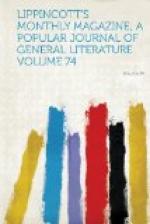This afternoon Epinglard is in a theorizing mood, and, after having sent for Bamboula, as he calls her familiarly, a dark-skinned model, he drapes her in a pale-yellow tulle dress, and proceeds to lament that so few Frenchwomen will wear yellow, owing to a silly popular prejudice. “Ah, madame la baronne,” he continues, “you cannot conceive what lovely combinations of rose and yellow I have made. Why not? There are roses with yellow pistils. Why should not we do in stuffs what nature does in flowers? For us couturiers, as for the painter and the sculptor, the great source of inspiration is nature. There are many of my colleagues who fill their portfolios with the engravings of Eisen, Debucourt, Moreau, and the masters of the eighteenth century. But this is not sufficient: we must go back to nature. I pass my summer in the country, and in the rich combinations of floral color I find the gamut of tones for my toilets. But I am allowing myself to theorize too much. If madame la baronne will be good enough to come to-morrow, I will compose something for her in the mean time. This afternoon I am scarcely in the humor for a creation of such importance.” And, with a grave salute, Epinglard passes into a saloon where two ladies are waiting impatiently, particularly the younger of the two, who has come, under the wing of her fashionable relative, to be introduced to the grand couturier.
“Bonjour, Monsieur Epinglard,” begins the elder. “I have come to ask you to create a masterpiece. It will not be the first time, will it? My niece is going to her first ball next month, and I wish her to have a dress on which your signature will be visible.”
Epinglard falls into a meditative pose, his elbow in one hand, his chin in the other, and looks long at the young girl, scrutinizing not only the line and modelling of the body, but the expression of the face, the eyes, the shade and nature of the hair, reading her temperament with the lucidity of a phrenologist aided by the divination of a plastic artist who has had great experience of feminine humanity. The examination lasts many minutes, and finally, as if under the inspiring influence of the god of taste, Epinglard, in broken phrases, composes the dress: “Toilette entirely of tulle ... corsage plaited diagonally ... around the decolletage four ruches ... the skirt relieved with drapery of white satin falling behind like a peplum ... on the shoulder—the left shoulder—a bouquet of myosotis or violets ... that is how I see mademoiselle dressed.” And Epinglard salutes gravely, while an assistant, who has noted down the prophetic utterances of the master, conducts the subject to a room in the centre of which is an articulated model of a feminine torso, with movable breasts, flattened rag arms hanging at the sides, and a combination of straps and springs to adjust the taille or waist,—a most sinister and grotesque object, all crumpled and




